1. Establish a Routine
Even with two young children, I involve them in the organizing process. It’s not always easy to get my two toddler boys to pick up after themselves. Yes, sometimes it would be much faster to do it myself, but you have to resist the urge to do it for them. Teach them where things should be put away, show them where their dirty clothes should go, and expect them to do it each time. A daily routine will help with this. At our house, we have a chore chart for my oldest. The chart also has items like get dressed, brush your teeth, etc. which help with the routine. I’m not saying schedule out every minute or even every hour of your day, but having a morning and bedtime routine will certainly help. My boys both help with things like putting their laundry away (see labels below), putting dishes away, cleaning up toys, etc. For older kids, the chores can be more involved.
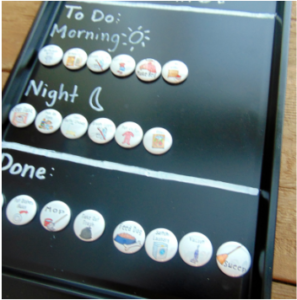
I should also mention that you don’t need a chore chart to establish a routine. Either way, just like with adults, after doing something over and over again, it becomes a routine. A chart can just help at the beginning with reminding your children what is supposed to be done each day. Then, you avoid hearing the question, “What do I have to do?” over and over again! Once they know that it is part of the routine, they will begin to just do it every day (well let’s be honest, most days 🙂 ).
I also have my own cleaning chart that I use to keep up on household chores. I will talk more about this in a future post. For me it is just part of my routine, and I don’t need to actually look at the chart anymore.
2. Positive Reinforcement
Here is where the teacher in me comes out! Modeling and positive reinforcement are two terms I constantly heard as a teacher, and that’s because they work! Model what you expect from your kids. Think of the old phrase, monkey see, monkey do. For me, I realized that if I don’t keep my room clean, how can I expect my 3 year old to know that he should keep his room clean?
Positive reinforcement can be done in many ways. You can use rewards such as “Good job!”, allowance, a treasure box, etc. along with your chore chart. A simple game like “Who can pick up the most legos?”, or “How many blue legos can you pick up?” works for us because my children are still young. For older kids, an allowance or special privilege may work. This is all going to depend on your family. For some families, there is no need for an allowance, a simple “Thanks for helping,” will work.
Toy bins should also be labeled, so that everyone knows where things belong. Even if your kids begin to remember where to put things, when the neighbor kids come over to play, they also know where things go! You can make picture labels of toys for the bins by googling the toy, or by simply taking a picture of the toy and printing it out. Don’t worry a whole post on everything labels is coming soon!

3. Label, Label, Label and Label Some More
I can’t say enough how much labels help our family. Even my husband needs the labels to remember where to put things :). I love using labels in kids’ rooms for everything from their toys to their sock drawer. I mentioned above that my children help put their clothes away. I made this easier form my 3 year old by labeling his drawers. Now, when he has a stack of clothes in his hands, he can just look at the pictures to see where everything goes. A quick Pinterest search of kids closet labels will give you many options of labels to use, or you can always make your own. The labels I used can be found here. Every morning my son gets himself dressed. These labels also make it easier for him to find the things he needs.

4. Simple Storage Solutions
A giant toy box that everything gets tossed inside of can quickly become a black hole where Mr. Potato Head’s ear gets lost and never found. My favorite solution is smaller bins or baskets on a shelf or bookcase. This way you can categorize toys and label the bins to match. It doesn’t matter what the inside of the bin looks like, because everything that belongs to that toy can be found right there in that basket, so Mr. Potato Head will never again have only 1 ear :). It’s also important to think about how accessible the items are. I store things like art materials, puzzles with lots of pieces, and other things that require supervision high on the shelves so that my children can’t reach them. The rest of the items are at a level that they can reach. They don’t have to ask me to get out each toy, or to help them put it back. These are little things that if you think about ahead of time, will save you time and headaches in the long run.
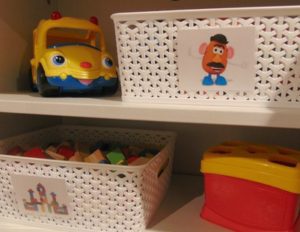
Having a designated space for all the things that come along with school aged children like backpacks, sports equipment, etc. is also important. With two small children at home, I don’t have to worry about this yet, but I do have a specific place for the diaper bag and other things. One solution for these things could be a mudroom. Now, I know a beautiful mudroom like the one pictured isn’t always possible. I can still keep dreaming of it though!
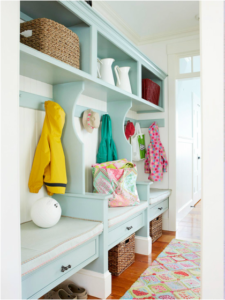
There are plenty of other solutions to store and hide these things. A sideboard or credenza can be used to separate each child’s things. This credenza from IKEA was used by Jen at iheartorganizing. Everything is neatly organized, there is a place for everything, and none of it can be seen!
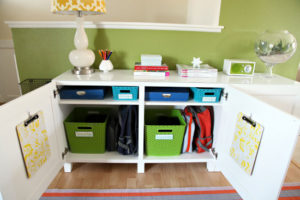
I also love how this closet was converted into a space to hang backpacks, coats, etc. Adding a small bench or shoe cubby to the bottom of this closet would create even more useable storage space.

5. Donate Regularly
In my home, we go through toys before each birthday and Christmas. My 3 year old goes through the toys with me. We talk about what he actually plays with, what might be too young for him, what is missing pieces, and so on. I explain that we are donating the toys to children who may not have as many toys as we do. He goes with me to donate the toys. He is a part of the entire process. Not only do I feel like this helps teach him a valuable life lesson, but it also gives him another look at organization. De-cluttering is part of the process. I ask him some of the same questions I ask my clients.
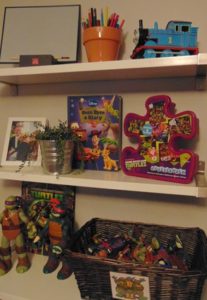
Organizing with kids is possible if you teach them the process. We end each day by doing a quick clean up of anything that we may have left out. Now, of course we are not perfect and there are plenty of days when you can find toys in every room of my house, and that’s okay. Don’t worry about purchasing expensive storage solutions for kids. Finding inexpensive shelves and baskets is perfect. It is always good to go back and reassess your space and think about what is and what is not working. Be flexible and make it part of your routine and you will see how much having an organized space can change your family’s life! If you are still feeling overwhelmed visit my services page to learn more about getting started.
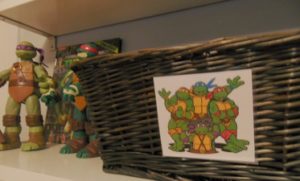
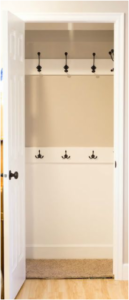

Love the idea of using smaller containers to keep like toys together!
Love all the ideas in the post especially the picture labels for bins!
Yes! This is my favorite tip! I did it all the time in the classroom and I thought, why not do the same for my own kids and it has been a total game changer!